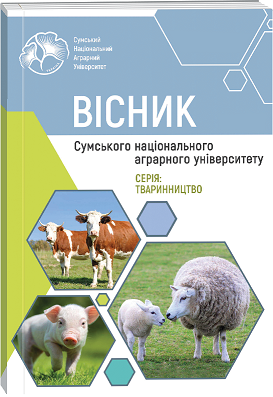EFFECTIVENESS OF THE APPLICATION OF OPTIONS FOR PRE-START FEEDING OF PIGLETS
Abstract
The research presented in this work is aimed at testing the influence of various types of pre-start feed on the growth, development and preservation of piglets in the nursery and post-weaning periods. The main boundary factor in growing piglets is the natural biological boundary of the lactation productivity of sows, which leads to a shortage of live milk in siblings and the need for early introduction of supplementary feed. The method of work is to assess the effectiveness of various prestarter feeds in one-year-old piglets and analyze their impact on productivity indicators. Research methods included experimental assessment of growth performance of piglets, saving rate, milk production of sows and feed efficiency. The investigation was carried out by the government on the basis of a scientific-government experiment, in which 12 sows and their offspring were tested. The piglets were divided into three groups, the skin of which received different options of pre-start feed: TM Best Mix 8393, Laktofit-Porco 1 (light) and Laktofit-Porco 2 (dark). The average weight gain, live weight of piglets at 35, 60 and 100 days, as well as the rate of their saving were analyzed. The results showed that until the 21st day, no statistically significant differences between the groups were recorded. However, the piglets that received Lactofit-Porco 1 showed better indicators of life expectancy, comparable to other groups. At the same time, piglets that were fed Lactofit-Porco 2 had slightly lower average growth rates. The highest indicators of productivity were recorded in the group that fed Best Mix 8393, the fragments of this compound feed better satisfied the consumption of piglets in older piglets after a decrease in the supply of milk from the mother. Until the 60th day of age, piglets from the first group have a low live weight of 4-6% equal to that of other groups, and their average weight gain remained consistently high. The discussed results indicate that the use of high-quality compound feeds allows minimizing feed stress in piglets after weaning, which has a positive impact on their growth and savings. Piglets that have been fed the Best Mix 8393 pre-starter are less susceptible to feed stress, adapting better to changing the diet and finding more effective feed intake. Recently, a cost-effective analysis demonstrated that the use of mixed feed from local breeding was less effective, resulting in additional costs of 2.08–2.35 mental units ($) per pig after separation from the world of five years. Thus, the results of the study confirm that clear pre-starter feed is an important factor in ensuring optimal growth of piglets and increasing the economic efficiency of pig farming. The use of pre-starter feeds, divided according to current technological standards, allows for the preservation of piglets, promotes their rapid adaptation and minimizes the negative effects of technological stress. The findings may be useful for the development of effective strategies for yearling piglets in industry minds.
References
2. Almeida, F. N., Sulabo, R. C., & Stein, H. H. (2014). Amino acid digestibility and concentration of digestible and metabolizable energy in a threonine biomass product fed to weanling pigs. Journal of Animal Science, 92(10), 4540–4546. https://doi.org/10.2527/jas.2013-6635
3. Altmann, B. A., Neumann, C., Rothstein, S., Liebert, F., & Mцrlein, D. (2019). Do dietary soy alternatives lead to pork quality improvements or drawbacks? A look into micro-alga and insect protein in swine diets. Meat Science, 153, 26–34. https://doi.org/10.1016/j.meatsci.2019.03.001
4. Avilйs-Gaxiola, S., Chuck-Hernбndez, C., & Serna Saldнvar, S. O. (2017). Inactivation methods of trypsin inhibitor in legumes: A review. Journal of Food Science, 83(1), 17–29. https://doi.org/10.1111/1750-3841.13985
5. Cappelaere, L., Le Cour Grandmaison, J., Martin, N., Lambert, W. (2021). Amino Acid Supplementation to Reduce Environmental Impacts of Broiler and Pig Production: A Review. Frontiers in veterinary science, 8, 689259. https://doi.org/10.3389/fvets.2021.689259
6. Council Directive, (2010). 86/609/EEC of 24 November 1986 on the approximation of laws, regulations and administrative provisions of the Member States regarding the protection of animals used for experimental and other scientific purposes. [Elektronnyi resurs]. – Rezhym dostupu: https://www.animallaw.info/statute/eu-research-council-directive-86609eec-regard-ing-protection-animals-used (data zvernennia 25.02.2025)
7. Dilger, A.C., Chen, X., Honegger, L.T. et al. The potential for gene-editing to increase muscle growth in pigs: experiences with editing myostatin. CABI Agric Biosci 3, 36 (2022). https://doi.org/10.1186/s43170-022-00106-6
8. Duarte, M.E., Parnsen, W., Zhang, S. (2024). Low crude protein formulation with supplemental amino acids for its impacts on intestinal health and growth performance of growing-finishing pigs. J Animal Sci Biotechnol 15, 55. https://doi.org/10.1186/s40104-024-01015-6
9. Durkin, I., Dadic, M., Brkic, D., Lukic, B., Kusec, G., Mikolin, M. (2012). influence of gender and slaugh-ter weight on meat quality traits of heavy pigs. Acta Agric Slov., 3, 211–4. https://doi.org/10.1139/ cjas-2017-0032
10. Gonzalez-Vega, J. C., & Stein, H. H. (2012). Amino acid digestibility in canola, cottonseed, and sunflower products fed to finishing pigs. Journal of Animal Science, 90 (12), 4391–4400. https://doi.org/10.2527/jas.2011-4631
11. Goodband, B., Tokach, M., Dritz, S., DeRouchey, J., & Woodworth, J. (2014). Practical starter pig amino acid requirements in relation to immunity, gut health and growth performance. Journal of Animal Science and Biotechnology, 5(1). https://doi.org/10.1186/2049-1891-5-12
12. Grinstead, G. S., Goodband, R. D., Nelssen, J. L., Tokach, M. D., & Dritz, S. S. (2000). A review of whey processing, products and components: Effects on weanling pig performance. Journal of Applied Animal Research, 17(1), 133–150. https://doi.org/10.1080/09712119.2000.9706296
13. Heyer, C.M.E., Jaworski, N.W., Page, G.I., & Zijlstra, R.T. (2022). Effect of Fiber Fermentation and Protein Digestion Kinetics on Mineral Digestion in Pigs. Animals (Basel), 12(16), 2053. https://doi.org/10.3390/ani12162053
14. Jha, R., & Berrocoso, J.D. (2015). Review: Dietary fiber utilization and its effects on physiological functions and gut health of swine. Animal, 9, 1441–1452. https://doi.org/10.1017/S1751731115000919
15. Khalak, V.I., & Gutyj, B.V. (2022). Riven fenotypovoho proiavu hodivelno-miasnykh yakostei molodniaku svynei riznoi vnutrishnoporodnoi dyferentsiatsii za deiakymy bahatokomponentnymy pokaznykamy otsinky. [Level of phenotypic manifestation of feeding and meat qualities of young pigs of different intrabreed differentiation according to some multicomponent evaluation indexes]. Ukrainian Journal of Veterinary and Agricultural Sciences, 5(1), 66–70. (in Ukrainian). https://doi.org/10.32718/ujvas5-1.11
16. Lindberg, J.E. (2014). Fiber effects in nutrition and gut health in pigs. Journal of Animal Science and Biotechnology, 5(1), 2–7. https://doi.org/15.10.1186/2049-1891-5-15
17. Masey O'Neill, H.V., Smith, J.A., & Bedford, M.R. (2014). Multicarbohydrase enzymes for non-ruminants. Asian- Australasian Journal Animal Sciences, 27(2), 290–301. doi:10.5713/ajas.2013.13261
18. McGlone, J.J. (2013). The Future of Pork Production in the World: Towards Sustainable, Welfare-Positive Systems. Animals (Basel). 3(2), 401-15. https://doi.org/10.3390/ani3020401
19. Nguyen, D.H., Park, J.W., & Kim, I.H. (2017). Effect of crumbled diet on growth performance, market day age and meat quality of growing-finishing pigs. J. Appl. Anim. Res., 45, 396–399. https://doi.org/10.1080/09712119.2016.1206904
20. Nortey, T.N., Patience, J.F., Simmins, P.H., Trottier, N L., & Zijlstra, R.T. (2007). Effects of individual or combined xylanase and phytase supplementation on energy, amino acid, and phosphorus digestibility and growth performance of grower swine fed wheat-based diets containing wheat millrun. J Anim Sci., 85, 1432–1443. https://doi.org/10.2527/jas.2006-613
21. Passos, A.A., Park, I., Ferket, P., von Heimendahl, E., & Kim, S.W. Effect of dietary supplementation of xylanase on apparent ileal digestibility of nutrients, viscosity of digesta, and intestinal morphology of growing pigs fed corn and soybean meal based diet. Animal Nutrition, 1(1), 19–23. https://doi.org/10.1016/j.aninu.2015.02.006
22. Patience, J.F., & Ramirez A. (2022). Invited review: strategic adoption of antibiotic-free pork production: the importance of a holistic approach. Transl Anim Sci., 6(3), txac063. https://doi.org/10.1093/tas/txac063
23. Shurson, G.C., Hung, Y.T., Jang, J C., & Urriola, P. E. (2021). Measures Matter-Determining the True Nutri- Physiological Value of Feed Ingredients for Swine. Animals (Basel), 11(5), 1259. https://doi.org/10.3390/ani11051259
24. Upadhaya, S.D., Yun, H.M., & Kim, I H. (2016). Influence of low or high-density corn and soybean meal-based diets and protease supplementation on growth performance, apparent digestibility, blood characteristics and noxious gas emission of finishing pigs. Anim Feed Sci Tech., 216, 281–287 https://doi.org/10.1016/j.anifeedsci.2016.04.003
25. Vahjen, W., Osswald, T., Scha¨fer, K., & Simon, O. (2007). Comparison of a xylanase and a complex of non-starch polysaccharide-degrading enzymes with regard to performance and bacterial metabolism in weaned piglets. Arch Anim Nutr., 61, 90–102. https://doi.org/10.1080/17450390701203881
26. Vyslotska, L., Gutyj, B., Khalak, V., Martyshuk, T., Todoriuk, V., Stadnytska, O., Magrelo, N., Sus, H., Vysotskyi, A., Vus, U., & Magrelo, V. (2021). The level of products of lipid peroxidation in the blood of piglets at the action feed additive “Sylimevit”. Scientific Messenger of LNU of Veterinary Medicine and Biotechnologies. Series: Agricultural Sciences, 23(95), 154-159. https://doi.org/10.32718/nvlvet-a9523
27. Yin, Y.L., Baidoo, S.K., Schulze, H., & Simmins, P.H. (2001). Effects of supplementing diets containing hulless barley varieties having different levels of non-starch polysaccharides with β-glucanase and xylanase on the physiological status of the gastrointestinal tract and nutrient digestibility of weaned pigs. Livest Prod Sci., 71, 97–107. https://doi.org/10.1016/S0301-6226(01)00214-7
28. Zhang, F., & Adeola, O. (2017). Techniques for evaluating digestibility of energy, amino acids, phosphorus, and calcium in feed ingredients for pigs. Anim Nutr., 3(4), 344. https://doi.org/10.1016/j.aninu.2017.06.008

 ISSN
ISSN  ISSN
ISSN 



